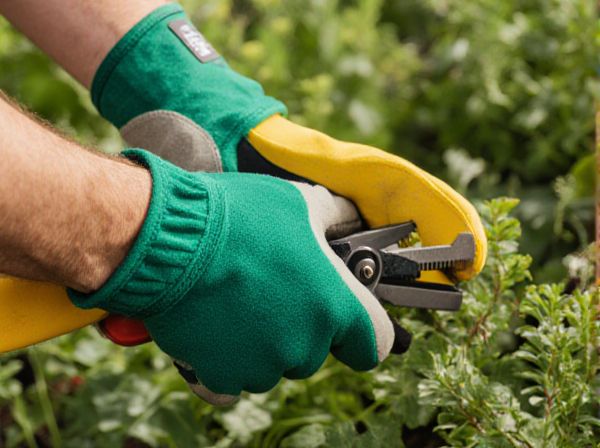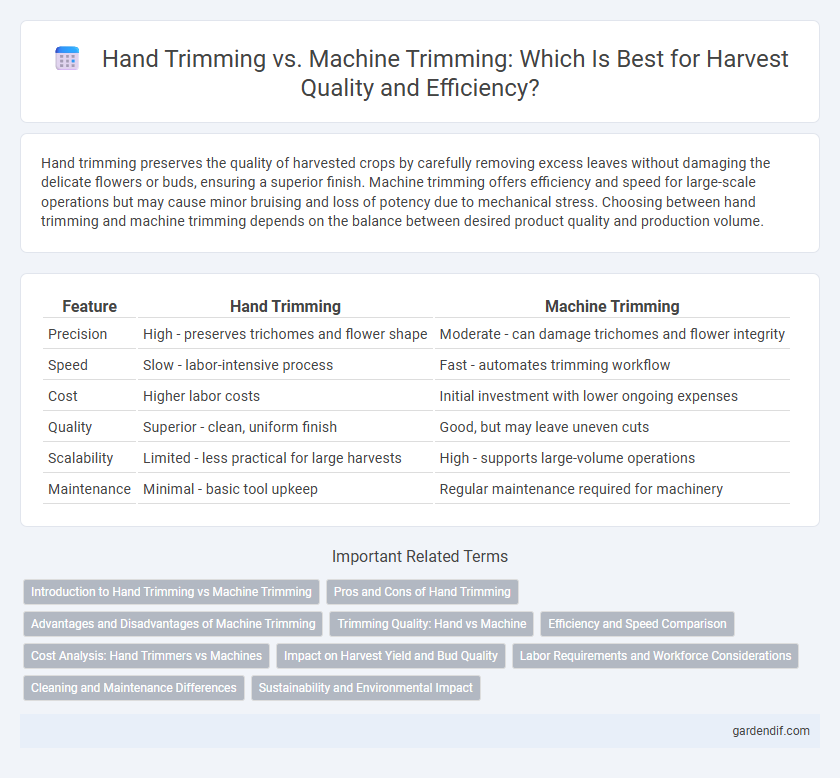
Hand Trimming vs Machine Trimming Illustration
Hand trimming preserves the quality of harvested crops by carefully removing excess leaves without damaging the delicate flowers or buds, ensuring a superior finish. Machine trimming offers efficiency and speed for large-scale operations but may cause minor bruising and loss of potency due to mechanical stress. Choosing between hand trimming and machine trimming depends on the balance between desired product quality and production volume.
Table of Comparison
| Feature | Hand Trimming | Machine Trimming |
|---|---|---|
| Precision | High - preserves trichomes and flower shape | Moderate - can damage trichomes and flower integrity |
| Speed | Slow - labor-intensive process | Fast - automates trimming workflow |
| Cost | Higher labor costs | Initial investment with lower ongoing expenses |
| Quality | Superior - clean, uniform finish | Good, but may leave uneven cuts |
| Scalability | Limited - less practical for large harvests | High - supports large-volume operations |
| Maintenance | Minimal - basic tool upkeep | Regular maintenance required for machinery |
Introduction to Hand Trimming vs Machine Trimming
Hand trimming involves using precision tools to carefully trim cannabis buds by hand, ensuring preservation of trichomes and overall quality. Machine trimming utilizes automated equipment designed for high-volume processing, offering increased speed and efficiency but potentially sacrificing some bud integrity. Choosing between hand and machine trimming depends on priorities such as quality, labor costs, and production scale.
Pros and Cons of Hand Trimming
Hand trimming preserves delicate trichomes and enhances the overall quality of the harvest by minimizing damage to the plant material, leading to a smoother, more flavorful final product. This method is labor-intensive and time-consuming, making it less efficient for large-scale operations and increasing production costs. However, hand trimming allows for superior control and precision, resulting in a visually appealing and premium-grade cannabis product.
Advantages and Disadvantages of Machine Trimming
Machine trimming offers rapid processing and high throughput, significantly reducing labor costs compared to hand trimming. However, it often results in less precise cuts that can damage delicate buds, affecting overall product quality and potency. While efficient for large-scale operations, machine trimming may compromise the aesthetic and cannabinoid profile preferred by connoisseurs.
Trimming Quality: Hand vs Machine
Hand trimming offers superior precision and delicacy, preserving trichome integrity and enhancing the overall quality of the harvested buds. Machine trimming can cause more damage to delicate structures, leading to the loss of precious cannabinoids and terpenes while speeding up processing time. Growers seeking premium-quality products often prioritize hand trimming to maintain optimal potency, flavor, and aesthetic appeal.
Efficiency and Speed Comparison
Hand trimming offers precision and preserves the integrity of delicate plants, but it is time-consuming and labor-intensive, making it less efficient for large-scale operations. Machine trimming significantly increases speed, processing large quantities quickly while reducing labor costs, but may cause slight damage to the product and result in lower overall quality. For commercial growers prioritizing efficiency, machine trimming is often preferred, whereas small-scale or artisanal producers may choose hand trimming for superior product appearance.
Cost Analysis: Hand Trimmers vs Machines
Hand trimming requires higher labor costs due to the intensive manual effort and time it consumes, often making it more expensive per pound compared to machine trimming. Machine trimming offers lower operational costs with faster processing speeds, but initial investment and maintenance expenses can be significant. Cost-effectiveness depends on scale, where small operations may favor hand trimming for quality, while large-scale harvests benefit from machine trimming's efficiency.
Impact on Harvest Yield and Bud Quality
Hand trimming preserves delicate trichomes and enhances bud quality by minimizing damage, resulting in a higher-value final product despite slower processing times. Machine trimming significantly increases harvest yield through faster processing but can compromise bud integrity by causing more physical damage and loss of resinous material. Prioritizing hand trimming optimizes cannabinoid and terpene retention, while machine trimming emphasizes efficiency in large-scale operations.
Labor Requirements and Workforce Considerations
Hand trimming demands a skilled workforce capable of precise, delicate cuts, often requiring more labor hours per pound of product compared to machine trimming. This method generally involves higher labor costs and slower processing times but results in a premium-quality product with minimal damage. Machine trimming significantly reduces labor needs and accelerates throughput but may require less specialized operators and can lead to higher rates of plant material loss or product damage.
Cleaning and Maintenance Differences
Hand trimming requires frequent cleaning of blades and scissors to prevent resin buildup, which can slow the process and affect plant quality. Machine trimming involves regular maintenance of sharp, rotating blades and mechanical parts, with lubrication and debris removal critical to avoid malfunction and ensure consistent performance. Both methods demand diligent sanitation practices to maintain hygiene and maximize trimming efficiency during harvest.
Sustainability and Environmental Impact
Hand trimming preserves the integrity of cannabis buds, reducing plant waste and minimizing energy consumption compared to machine trimming. Machine trimming often requires electricity from non-renewable sources and generates more plant material discard, contributing to a larger carbon footprint. Sustainable cultivation favors hand trimming to support environmentally responsible practices and reduce landfill contributions.
Hand Trimming vs Machine Trimming Infographic

 gardendif.com
gardendif.com